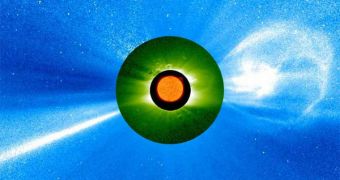Irish researchers from the Trinity College in Dublin have recently revealed that solar storms can change directions after being produced by the Sun.
The new finding goes against established theories, which state that storms go in a straight direction once they are produced. This is the first investigation to prove this scientifically.
According to the researchers, the newly-discovered behavior does not take place all the time. Rather, storms only change directions when the amount of solar activity increases considerably.
“This really surprised us. Solar coronal mass ejections (CMEs) can start out going one way – and then turn in a different direction,” says TC research scientist Peter Gallagher, quoted by Space.
The observations that lead to the new conclusions were carried out using the twin Solar Terrestrial Relations Observatory (STEREO) spacecrafts, which belong to the American space agency.
These instruments provide a unique view of the Sun, because they are set in the same orbit, but spaced widely apart. This allows them to create a 3D view of the star, similar to how it would look like to human eyes.
But the researchers who conducted the new investigation could not believe their eyes when they first looked over the data, and thought they had made a mistake.
They were only convinced they got things right after checking the results three times over. More than a dozen solar eruptions were analyzed, the team reveals, and all datasets pointed at the same conclusion.
“Our 3D visualizations clearly show that solar storms can be deflected from high solar latitudes and end up hitting planets they might otherwise have missed,” explains the leader of the new study, TC expert Jason Byrne.
He is a graduate student at the College's Center for High Performance Computing. The scientist and his group created fully stereoscopic models of the storm's particle clouds using STEREO.
Then they traced these clouds as they spread out through space, and discovered that the path they take is not always a straight one.
“The ability to reconstruct the path of a solar storm through space could be of great benefit to forecasters of space weather at Earth,” explains NASA expert Alex Young.
“Knowing when a CME will arrive is crucial for predicting the onset of geomagnetic storms,” adds the scientist, who holds an appointment as a STERE senior scientist at the Goddard Space Flight Center (GSFC), in Greenbelt, Maryland.

 14 DAY TRIAL //
14 DAY TRIAL //